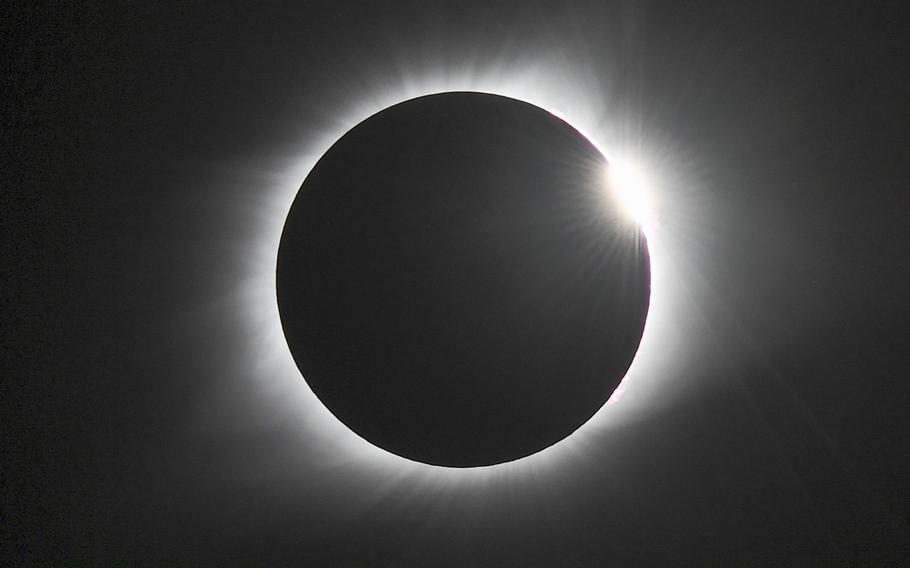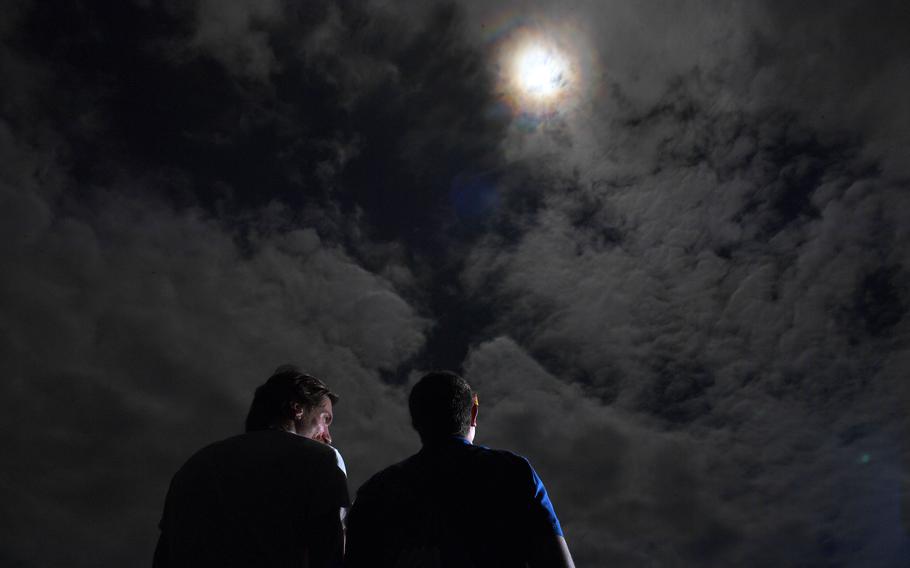
A total eclipse of the sun, viewed in Hopkinsville, Ky. (Jonathan Newton/The Washington Post)
On April 8, the moon will photobomb our view of the sun, creating a rare total solar eclipse that will be seen in Mexico, across the eastern half of the United States and as far north as Newfoundland, Canada. The beauty of the celestial event is enough reason to document it, but scientists have also set up projects to study its effects. Some of the projects enlist the help of eclipse viewers, including you.
While the eclipse occurs way above our heads, the effects on Earth can be very personal. The moon’s shadow reaches Earth’s atmosphere and surface. The sudden darkness affects animal behavior, including that of the humans who know it’s coming. It affects chemical reactions around us and what we can see in space.
“It’s a once-in-a-lifetime opportunity. It’s going over hugely populated areas of the U.S., and everyone should make an attempt to see it,” said Liz MacDonald, citizen science lead for NASA’s heliophysics department. Although the last total solar eclipse seen in the United States occurred in 2017, there won’t be another one until 2044.
Observations on Earth’s surface ...
As a viewer, you may notice a change in the sounds around you. Birds might stop chirping and crickets might start. Nocturnal owls and bats could begin to stir.
One project has equipped people to help document changes in sounds. Using specialized audio recorders, scientists and nonscientists will record cricket sounds through a project called Eclipse Soundscapes. The project revisits a similar study conducted in 1935, when a scientist put out a newspaper ad asking people to submit their observations. Near totality, for example, it was reported that crickets began chirping as if it were evening.
Park rangers at Arkansas’s Hot Springs National Park are setting up high-end recorders in the hope of capturing the sounds of endangered bats, which could help them learn about the health of the population. As long as the bats aren’t still hibernating, this could be the first time their sounds are recorded during an eclipse in the park.
“Solar eclipses are multisensory events,” said MaryKay Severino, co-founder and education director of Eclipse Soundscapes. “It’s about how are you going to experience the eclipse, and that can be done with all different senses.”
Air temperature typically plummets 10 degrees Fahrenheit during totality. Using the GLOBE Observer app, people can report temperature and clouds. The data will help NASA scientists learn more about what happens when you temporarily turn off the sun on our solar-powered Earth. Anyone can participate in the project by downloading the app.

People watch the Aug. 21, 2017, eclipse during a viewing party at the former MUSC Health Stadium in Charleston, S.C. (Matt McClain/The Washington Post)
And in Earth’s atmosphere ...
More subtle changes — at least to the casual viewer — occur in the atmosphere, including layers that affect our weather. To gather information, one project led by Montana State University is sending up helium-filled balloons with scientific instruments.
Student teams from various institutions will send balloons from the ground to the stratosphere, where the ozone layer lies, to capture data. The teams aim to determine, for example, at which altitude the temperature drop is largest, as well as the lag between the drop in sunlight and a drop in surface temperature. They will also be testing how far video streaming can be reliably transmitted, by live-streaming a balloon’s ascent during the eclipse. You can watch that here.
The teams will also be studying the creation of turbulent air waves in our atmosphere, called gravity waves. They form where air is disturbed, rippling like a stone dropped in a still pond.
“When you’re in an airplane flying low over mountains, the turbulence you feel is most likely from gravity waves,” said Thomas Colligan, a scientific software developer at NASA. He and his teammates were the first to document a gravity wave created by a total solar eclipse during the 2019 event.
Gravity waves can be created by mountains, thunderstorms, explosions — and eclipses. The moon’s shadow cools the atmosphere, creating gravity waves, analogous to the bow of a ship moving through water, said Colligan.
Atmospheric gravity waves can affect temperature and atmospheric chemistry, and can create clouds. A more detailed understanding of how gravity waves work could improve weather models and forecasts.
Higher up ...
Looking above the stratosphere, scientists will study eclipse effects on the ionosphere — where Earth’s atmosphere meets space. The ionosphere is home to all of the charged particles in Earth’s atmosphere and many of our satellites. Sudden changes in this layer, such as from an eclipse, could affect communication systems — at least that’s what some experts and citizen scientists are hoping to observe.
Through the HamSCI project, amateur radio operators, using high-frequency radios, will try to make contacts in as many different locations as they can during totality. During the eclipse, the sun temporarily stops electrifying the ionosphere, so signals could be heard from much farther away than usual or could disappear. Although the eclipse will be over North America, high-frequency radio signals could be transmitted across the world.
“For people who are not directly underneath the line of totality, they can actually listen to the eclipse on their radios,” said Ruth Bamford, a research scientist at Britain’s Rutherford Appleton Laboratory. For instance, you might be able to hear a radio station before the eclipse but then have it disappear during the eclipse. Or a radio station could fade in and out during the eclipse.
Given that scientists know exactly when and where the moon’s shadow will occur in the eclipse, Bamford said they can model what they expect to happen and compare that against the observations. Although she is not part of the current HamSCI experiment, her previous experiments revealed how charges in the ionosphere recombine at different rates.
“This kind of experiment provides an enormous amount of data that we can’t get at any other time,” Bamford said. It “offers an opportunity for us to test our models of what the Earth’s atmosphere does.”
And on our sun
It may seem odd that scientists want to study the sun when most of it is blocked by the moon. But that obstruction is precisely why they are pointing their instruments at our host star. Our sun’s disk is so bright that it washes out our ability to study the sun’s outer edge, but the moon hides the disk during the eclipse and allows for prime views of the solar outer halo.
“The sun is a long way away, and the eclipse is a special opportunity to see the edge of the sun that we don’t normally get to see,” said MacDonald, a space scientist at NASA.
This time around, scientists want to answer at least a pretty basic solar question: How big is the sun?
They have a decent idea, but there’s still a large margin of error, said MacDonald. Using the SunSketcher app, anyone can take pictures of a phenomenon known as Bailey’s Beads on the sun before and after the eclipse and help scientists determine the shape and extent of its outer edge.
Several other projects will also study the dynamics of the sun’s outermost layer, called the corona. For a citizen science project called Citizen CATE, volunteers will take images of the corona in polarized light to study the flow of the solar wind, how the solar wind is generated and how structures in the corona are connected.
NASA airplanes will fly during the eclipse at 50,000 feet above Earth’s surface to learn more about the temperature and chemical composition of the corona and explosions on the sun’s surface, known as coronal mass ejections. The planes will carry scientific instruments that will also take images in infrared and visible light that will help scientists study the dust ring around the sun and locate any asteroids near it.
The eclipse may also help reveal how the extremely hot ionized gas that makes up the sun, called plasma, flows through its outer layers. For the Eclipse Megamovie, volunteers will take photos of the eclipse to study how plasma flows through the corona and chromosphere (just below the corona). The researchers have photos from this project in 2017, but they expect 2024 to be more interesting because the sun is entering a particularly active period known as a solar maximum.
“Every couple of years, you get a chance to do these very rare observations,” MacDonald said. “As a scientist, I’m excited by the opportunities that people will experience this and want to experience more. There are many different ways that they could potentially participate with the science.”